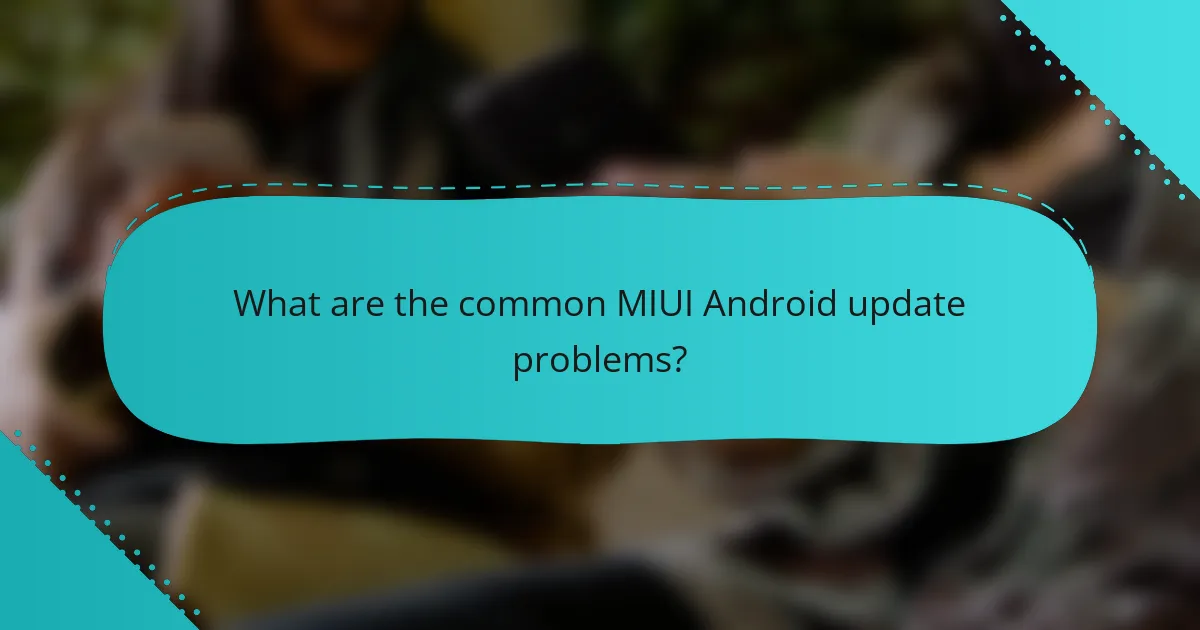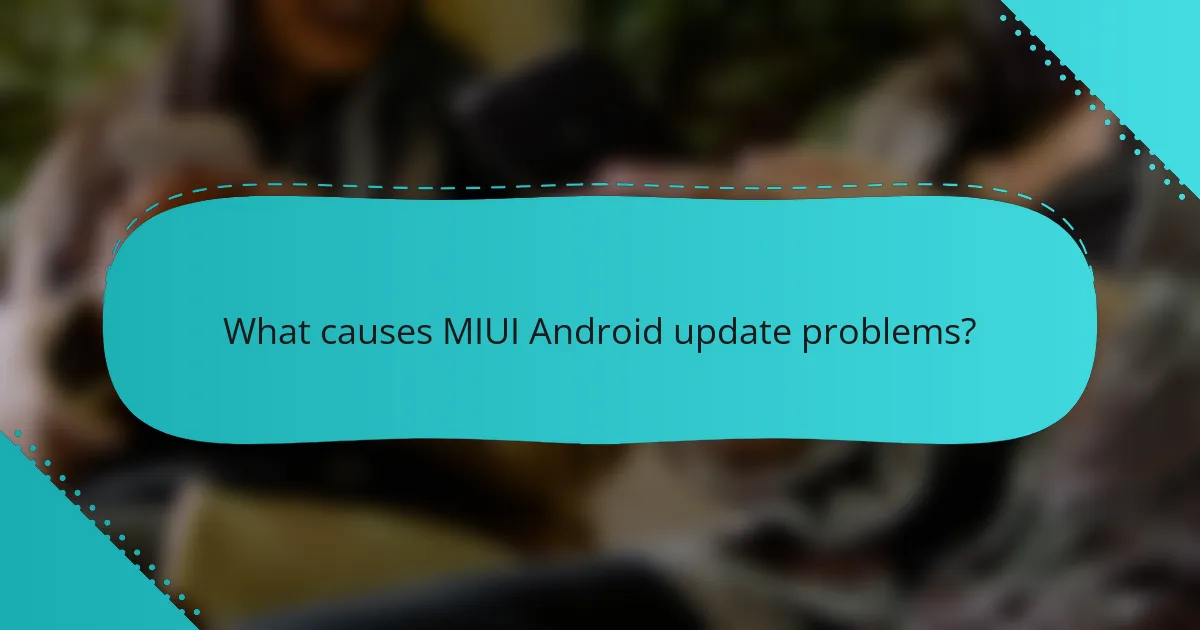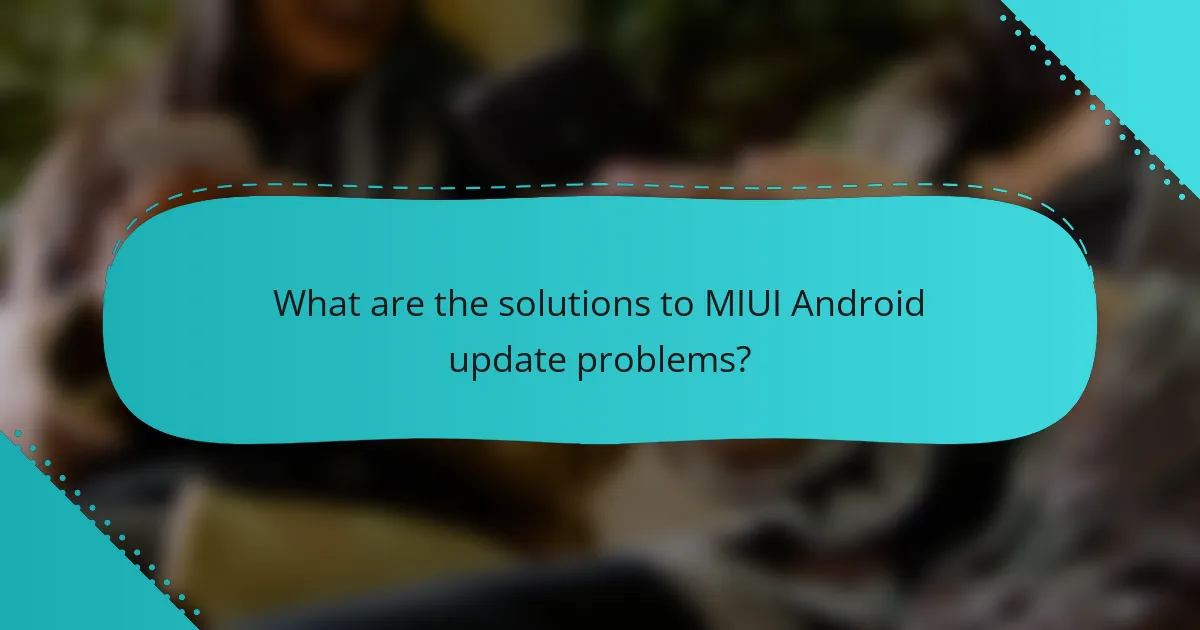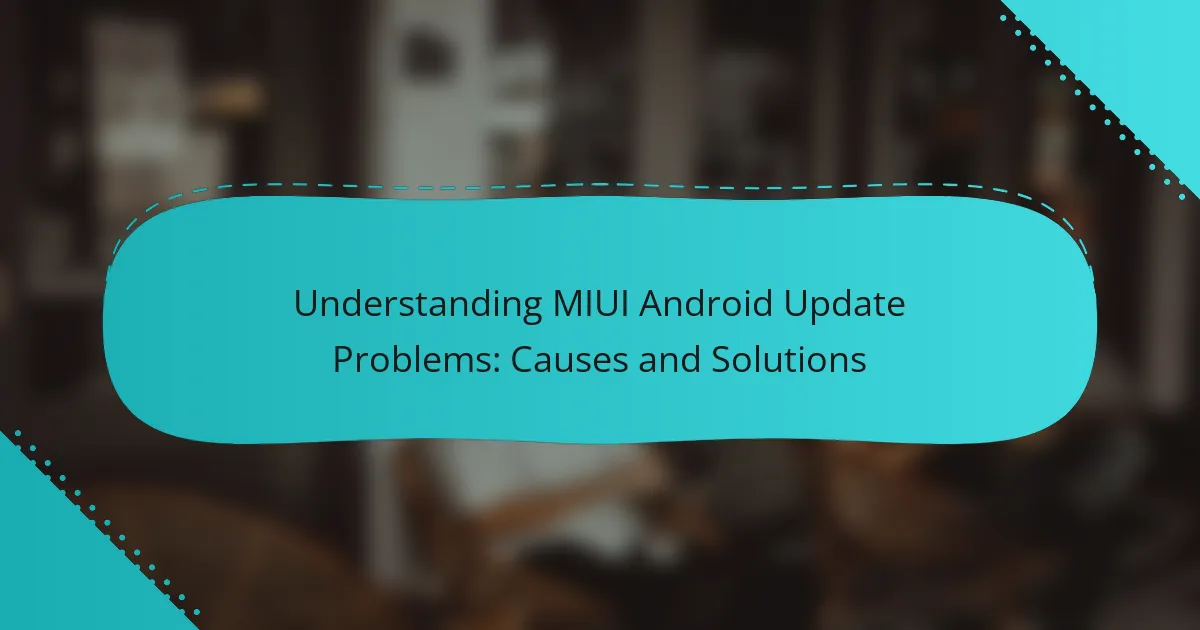
What are the common MIUI Android update problems?
Common MIUI Android update problems include issues such as system lag, app crashes, and battery drain. Users often report that their devices become slower after an update. This can be due to increased resource demands of the new software. App compatibility is another frequent issue. Some apps may not function properly after an update, leading to crashes or errors. Battery performance can also decline, with users experiencing faster battery drain. Connectivity problems, like Wi-Fi or Bluetooth failures, are also reported post-update. Lastly, users may encounter bugs or glitches that affect overall functionality. These problems are common across various MIUI versions and can impact user experience significantly.
Why do MIUI updates fail to install?
MIUI updates fail to install due to various reasons such as insufficient storage space, software bugs, or network issues. Insufficient storage can prevent the update from downloading or installing properly. Software bugs in the current MIUI version may lead to conflicts during the update process. Network issues can interrupt the download, leading to a failed installation. Additionally, using an incompatible device or version can also cause installation failures. According to user reports, these factors commonly contribute to update issues across different MIUI versions.
What are the error messages associated with failed updates?
Common error messages associated with failed updates include “Update Failed,” “Insufficient Storage,” and “Verification Failed.” “Update Failed” indicates that the installation process could not be completed. “Insufficient Storage” means there is not enough space on the device to download or install the update. “Verification Failed” suggests that the update package is corrupt or incompatible with the device. Other messages may include “Installation Aborted” and “Network Error.” These errors often stem from issues like poor connectivity or conflicting software.
How does device storage affect update installations?
Device storage significantly impacts update installations on Android devices. Insufficient storage can prevent updates from being downloaded or installed. Updates require a certain amount of free space to unpack and install files. If the available storage is less than the required space, the installation process will fail. For example, Android updates often need several hundred megabytes of free space. Additionally, low storage can lead to performance issues during the update process. Thus, maintaining adequate free storage is essential for successful update installations.
What issues arise after a successful MIUI update?
After a successful MIUI update, users may experience issues such as battery drain, app crashes, and connectivity problems. Battery drain occurs due to background processes that may not optimize correctly after the update. App crashes can result from compatibility issues between the updated MIUI version and existing applications. Connectivity problems may arise with Wi-Fi or Bluetooth, affecting device performance. Additionally, some users report lagging or slow response times, which can be linked to software bugs introduced during the update. These issues have been documented in user forums and tech support discussions, confirming their prevalence among MIUI users post-update.
How can performance issues manifest after an update?
Performance issues can manifest after an update in several ways. Users may experience slower app loading times. Increased battery drain is another common symptom. Some devices may face lag during multitasking. Users might notice unresponsive touchscreens or delayed inputs. Connectivity problems, such as Wi-Fi or Bluetooth issues, can also arise. Additionally, certain apps may crash or fail to open entirely. These issues often occur due to compatibility problems with new software. In some cases, bugs introduced in the update can lead to these performance declines.
What are the common bugs that users report post-update?
Common bugs reported by users post-update include battery drain issues, app crashes, and connectivity problems. Users frequently experience rapid battery depletion after installing updates. Many apps may become unresponsive or crash unexpectedly following the update. Connectivity issues, such as Wi-Fi or Bluetooth failures, are also commonly noted. Additionally, some users report interface lag or performance slowdowns. These problems are often linked to software incompatibilities introduced during the update. Reports from user forums and tech support channels frequently highlight these issues.

What causes MIUI Android update problems?
MIUI Android update problems are often caused by software bugs, compatibility issues, and insufficient storage space. Software bugs can arise during the update process, leading to system instability. Compatibility issues may occur when the device hardware does not support the new features in the update. Insufficient storage space can prevent the update from downloading or installing properly. Additionally, network connectivity problems can disrupt the update process. These factors contribute to the overall challenges faced during MIUI Android updates.
How do software compatibility issues contribute to update failures?
Software compatibility issues directly lead to update failures by preventing the new software from functioning correctly with existing hardware or software. Incompatible drivers can cause systems to crash or freeze during the update process. Additionally, outdated applications may conflict with new system requirements, resulting in errors. Hardware limitations can also restrict the installation of updates designed for newer devices. According to a study by Microsoft, 60% of update failures are attributed to compatibility problems. This statistic highlights the significant impact of compatibility on successful software updates.
What role does device model play in update compatibility?
Device model significantly influences update compatibility. Each device model has specific hardware and software configurations. These configurations determine whether a device can support new updates. For instance, older models may lack the processing power or memory required for the latest software features. Manufacturers often optimize updates for newer models, leaving older ones behind. Additionally, some features may not be compatible with older hardware. This leads to a fragmented update experience across different models. Consequently, users of older devices may miss out on important security patches and enhancements.
How do regional settings affect update availability?
Regional settings significantly impact update availability for MIUI Android devices. Manufacturers often release updates based on geographical regions. This strategy allows for tailored features and optimizations suited to local markets. For example, a device set to a specific region may receive updates that include language support or regional services. Additionally, carriers in certain regions may have their own schedules for rolling out updates. This can lead to delays for users in those areas compared to others. Consequently, users with incorrect regional settings may miss important updates or receive them later than expected.
What impact do network conditions have on MIUI updates?
Network conditions significantly impact MIUI updates. Poor network connectivity can lead to incomplete downloads or failed installations. A stable and fast internet connection is essential for successful updates. Slow speeds may result in longer update times and potential errors. Additionally, network interruptions can cause updates to be corrupted. Users should ensure a reliable Wi-Fi connection for optimal update performance. This is especially important for large update files. Overall, better network conditions facilitate smoother MIUI update processes.
How does a weak internet connection impede the update process?
A weak internet connection significantly slows down the update process. It can lead to incomplete downloads or failed installations. Updates often require large files that need stable bandwidth. When the connection is weak, data packets can be lost or delayed. This results in timeouts during the update process. Consequently, users may experience prolonged update times or errors. According to a study by the Pew Research Center, 25% of users reported issues with slow internet affecting software updates. Thus, a weak connection directly impedes the efficiency and success of the update process.
What are the best practices for ensuring a stable connection during updates?
To ensure a stable connection during updates, use a reliable Wi-Fi network. A strong Wi-Fi signal prevents interruptions. Avoid public networks as they may be unstable. Keep the device charged above 50% before starting the update. Low battery can lead to shutdowns during the process. Disable any VPNs or proxies that may interfere with the connection. These can slow down or disrupt the update. Finally, pause any background applications that consume bandwidth. This prioritizes the update process for a smoother experience.

What are the solutions to MIUI Android update problems?
To resolve MIUI Android update problems, users can follow several steps. First, ensure that the device has sufficient storage space for the update. Insufficient storage can prevent updates from installing properly. Next, check the internet connection. A stable Wi-Fi connection is necessary for downloading updates.
Additionally, users should clear the cache of the updater app. This can help eliminate any corrupted data causing issues. Restarting the device can also resolve minor glitches that interfere with the update process.
If problems persist, users may consider manually downloading the update from the official Xiaomi website. This method can bypass issues related to the automatic update process. Finally, performing a factory reset can be a last resort solution. This action can fix deep-rooted software issues but should be done with caution, as it erases all data on the device.
How can users troubleshoot installation failures?
Users can troubleshoot installation failures by following a series of systematic steps. First, they should check their device’s storage space to ensure sufficient availability for the installation. Insufficient storage can cause installation errors. Next, users should verify their internet connection. A stable connection is essential for downloading updates. Restarting the device can also resolve temporary software glitches that may hinder installation.
If the issue persists, users should clear the cache of the updater app. This can remove any corrupted files that might be causing the problem. Additionally, users can check for compatibility issues with their device model and the update version. Ensuring that the device is compatible can prevent installation failures.
Finally, users may consider performing a factory reset as a last resort. This action can resolve deep-rooted software issues but should be done with caution. These steps are effective in addressing common installation failures in MIUI Android updates.
What steps should be taken to free up storage space?
Delete unnecessary files and apps to free up storage space. Start by reviewing your installed applications. Uninstall apps that you no longer use or need. Next, clear cache and data from apps to reclaim space. Go to settings and select storage management options. Remove duplicate photos and large media files. Utilize cloud storage for backups to reduce local storage usage. Lastly, consider using storage optimization tools available on your device. These steps effectively increase available storage on your device.
How can users clear cache and data for system apps?
Users can clear cache and data for system apps by navigating to the device settings. First, open the “Settings” app on your device. Next, select “Apps” or “Applications.” Then, tap on “Manage apps” or “App info.” Locate the specific system app you wish to clear. Once selected, tap on “Storage.” Here, users will find options to “Clear Cache” and “Clear Data.” Tapping these options will remove temporary files and reset the app to its default state. This process helps resolve performance issues related to system apps.
What are the recommended methods for resolving post-update issues?
To resolve post-update issues on MIUI Android devices, users should follow several recommended methods. First, perform a soft reset by restarting the device. This action can clear temporary glitches caused by the update. Second, check for additional updates. Sometimes, manufacturers release patches to fix bugs in the initial update. Third, clear the cache partition. This process can remove outdated system files that may be causing issues. Fourth, reset app preferences to ensure all apps are functioning correctly. Fifth, perform a factory reset as a last resort. This method restores the device to its original settings, resolving persistent problems. According to user feedback, these methods have been effective in addressing common post-update issues.
How can users revert to a previous MIUI version if necessary?
Users can revert to a previous MIUI version by accessing the official MIUI website or forums. They need to download the desired MIUI ROM file compatible with their device. After downloading, users should enable USB debugging in their device settings. Next, they must boot their device into recovery mode. In recovery mode, users can select the option to install the downloaded ROM file. Following the on-screen instructions, the installation process will overwrite the current MIUI version. Finally, users should reboot their device to complete the process. This method is commonly used by MIUI users to restore previous versions effectively.
What resources are available for reporting and fixing bugs?
Resources for reporting and fixing bugs include official forums, bug tracking systems, and community support channels. Official forums, like Xiaomi’s MIUI forum, allow users to report issues directly. Bug tracking systems, such as JIRA or Bugzilla, help developers manage and prioritize bug fixes. Community support channels, like Reddit or Facebook groups, provide user-generated solutions and advice. These platforms enable users to share experiences and collaborate on troubleshooting. Additionally, many manufacturers offer dedicated support websites with guides and FAQs for common issues.
What tips can help ensure a smooth update process?
To ensure a smooth update process, users should back up their data before starting. This prevents data loss during the update. Users should also ensure their device has sufficient battery life, ideally above 50%. A stable Wi-Fi connection is crucial for downloading large update files. Users should clear cache and unnecessary files to free up space. Checking for device compatibility with the new update is essential. Following official update instructions from the manufacturer minimizes errors. Users should avoid interrupting the update process once it begins. Finally, keeping the device updated with the latest security patches prior to major updates can enhance stability.
How can users prepare their devices before an update?
Users can prepare their devices before an update by backing up important data. This ensures that personal files are safe in case of issues during the update. Users should also free up storage space on their devices. A minimum of 1-2 GB of free space is typically recommended for updates. Additionally, users should check for a stable internet connection. A reliable Wi-Fi connection helps avoid interruptions during the download process. It is also advisable to charge the device to at least 50% battery life. This prevents the device from shutting down during the update. Lastly, users should disable any active security apps temporarily. Some security software may interfere with the update process.
What are the best practices for keeping MIUI up to date without issues?
To keep MIUI up to date without issues, regularly check for updates in the settings menu. Navigate to Settings, then About Phone, and select System Updates. Ensure a stable internet connection before downloading updates. Use Wi-Fi for larger updates to avoid data charges. Backup your data before updating to prevent loss. Clear cache in the updater app to resolve potential issues. Avoid installing beta versions unless you are comfortable with potential bugs. Finally, read user feedback on updates for insights on performance and issues. These practices help maintain device stability and performance during updates.
The main entity of this article is MIUI Android updates, which are known to present various problems for users. Common issues include system lag, app crashes, battery drain, and installation failures, often stemming from insufficient storage, software bugs, and compatibility challenges. The article explores the causes of these update problems, outlines error messages associated with failed installations, and provides troubleshooting steps to resolve post-update issues. Additionally, it offers best practices for ensuring a smooth update process and highlights the importance of device compatibility and stable network conditions in achieving successful updates.
